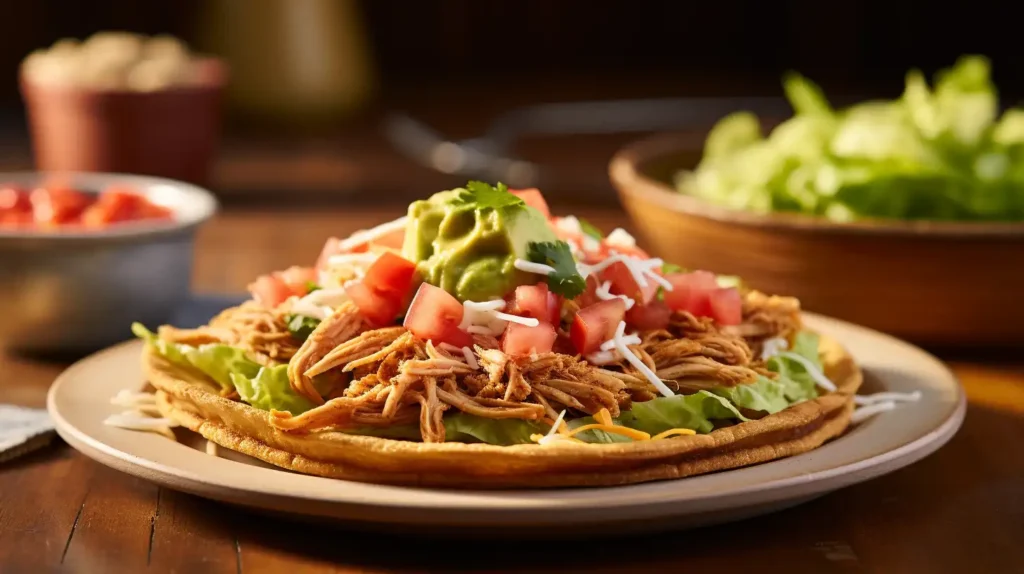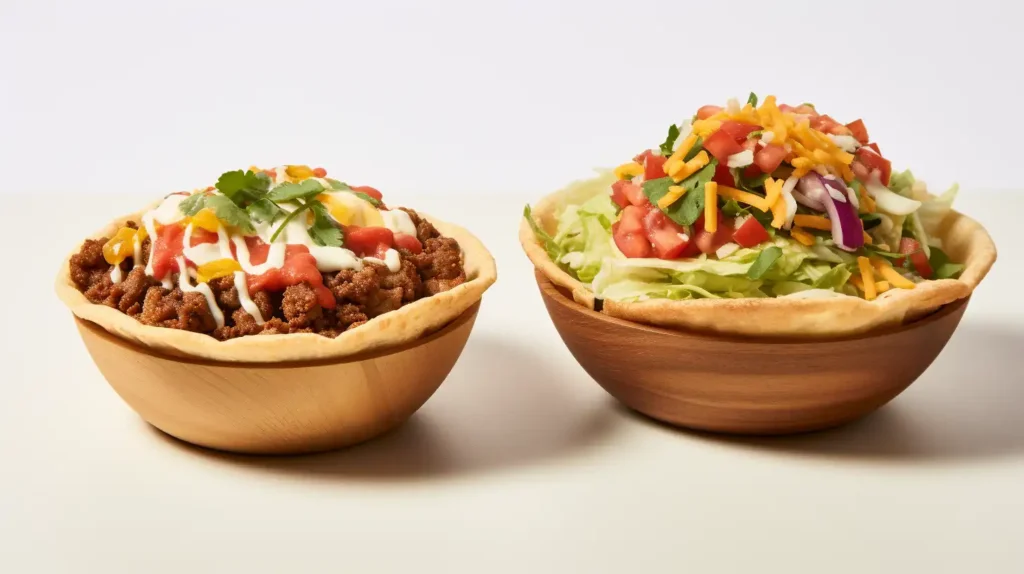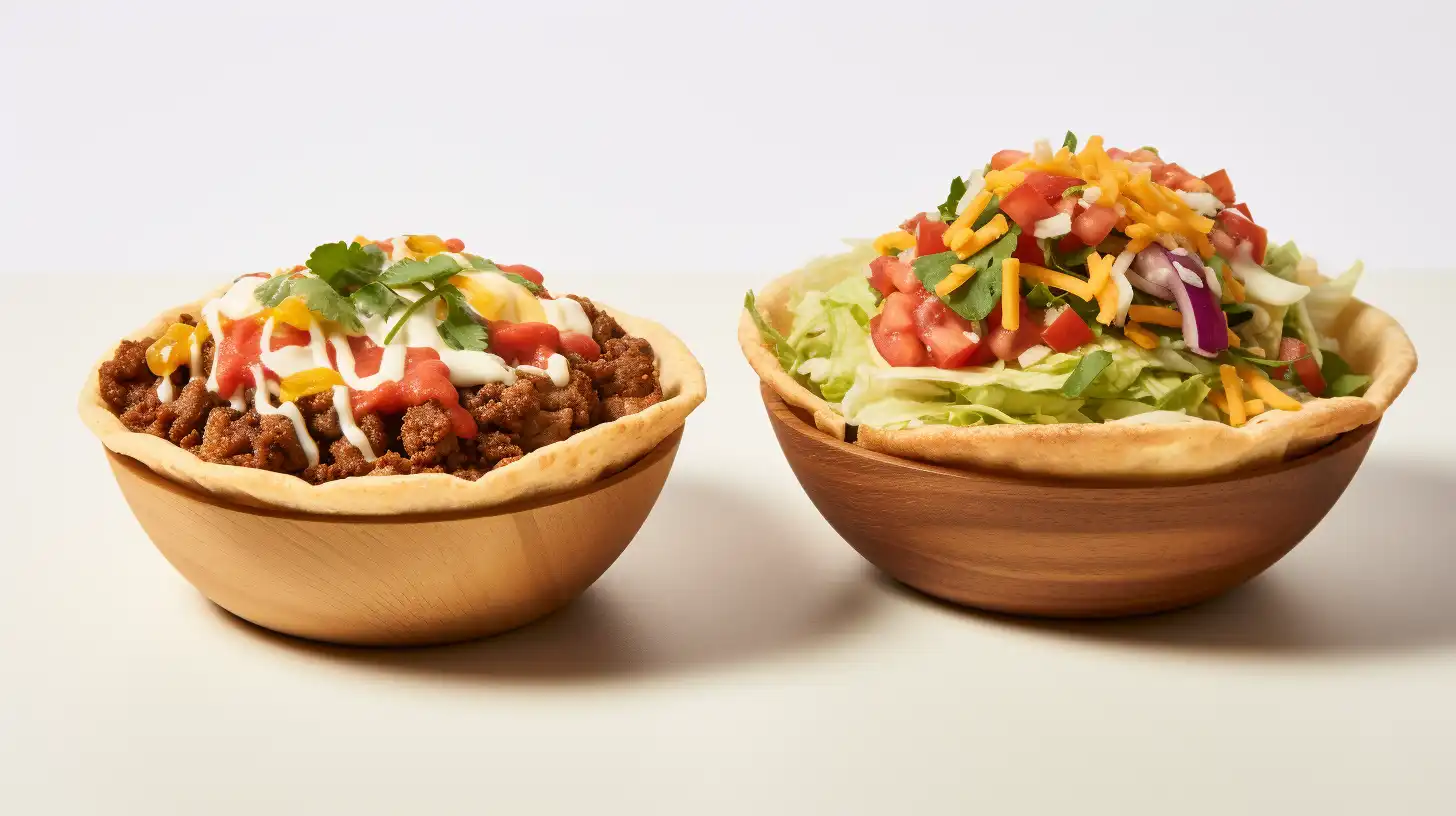Introduction
Whats the difference between a tostada and a taco bowl? Many people assume they’re the same since both are packed with delicious toppings. However, their structures, textures, and preparation methods set them apart. In this article, we’ll dive into their differences, from origins to the way they’re eaten. Whether you’re a food lover or just curious, this guide will satisfy your appetite for knowledge.
Understanding Tostadas
What Is a Tostada? Exploring What’s the Difference Between a Tostada and a Taco Bowl
The word “tostada” comes from the Spanish term for “toasted.” To understand what’s the difference between a tostada and a taco bowl, we start with the tostada. It’s a crispy, flat tortilla base, often made of corn, and serves as the foundation for an array of delicious toppings. This dish has deep roots in Mexican cuisine, with its origins dating back centuries when stale corn tortillas were toasted to extend their usability.
How Are Tostadas Traditionally Made?
Creating a tostada starts with frying or baking a tortilla until it’s golden and crispy. While traditionally fried, many modern recipes embrace baking for a healthier twist. The crispy tortilla forms a sturdy base for layering ingredients.
Typical toppings include:
- Refried beans: Often used as the first layer to hold everything together.
- Proteins: Shredded chicken, beef, or seafood like ceviche are popular choices.
- Vegetables: Diced tomatoes, lettuce, and sliced onions add freshness and crunch.
- Dairy: A sprinkle of queso fresco or shredded cheese for a creamy touch.
- Salsas and sauces: Pico de gallo, salsa verde, or a drizzle of crema complete the flavor profile.
Tostadas are open-faced and meant to be eaten with your hands, though it’s a bit of a balancing act to keep the toppings in place!
Regional Variations of Tostadas
Mexico’s regional diversity shines in its versions of tostadas. In coastal areas like Baja California, seafood tostadas featuring fresh shrimp, octopus, or tuna dominate. Inland regions, however, prefer heartier toppings such as slow-cooked pork or shredded beef. Whatever the variation, the base remains a crispy tortilla, making the dish unmistakably a tostada.
Defining Tostadas

What Is a Tostada?
A tostada is a quintessential dish in Mexican cuisine, known for its simplicity and versatility. The name “tostada” translates to “toasted” in Spanish, reflecting its preparation style. While the dish might look straightforward, its history and significance are anything but ordinary.
Tostadas originated as a practical way to use leftover tortillas. Instead of discarding tortillas that had gone stale, early cooks would toast or fry them, creating a crispy and durable base perfect for toppings. Over time, what started as a resourceful method evolved into a culinary tradition, loved both in Mexico and internationally.
Traditional Preparation Methods
Crafting the perfect tostada begins with the tortilla, typically made from corn. Traditionally, these tortillas are fried in oil until golden and crunchy, but modern methods often include baking for a healthier approach. The resulting base is crispy and sturdy, designed to hold layers of flavorful toppings without falling apart.
The key to a great tostada lies in the harmony of textures and flavors. The crunch of the tortilla contrasts beautifully with the softness of beans or guacamole, the juiciness of proteins, and the freshness of vegetables.
Common Ingredients and Toppings
The beauty of tostadas is their adaptability. They can be customized to suit different palates while maintaining their signature structure.
Base: Crispy Corn Tortilla
The foundation of every tostada is its crisp, golden tortilla. This provides the perfect vessel for stacking toppings.
Typical Toppings:
- Refried Beans: A creamy and hearty layer that helps toppings stick.
- Proteins: Popular options include shredded chicken, beef, carnitas, or seafood like shrimp or tuna.
- Vegetables: Fresh ingredients like lettuce, diced tomatoes, sliced onions, and radishes add color and crunch.
- Dairy: A sprinkle of queso fresco or a dollop of sour cream balances the flavors.
- Salsas: Pico de gallo, salsa roja, or salsa verde bring heat and acidity to the dish.
Regional Variations
Coastal Regions: Seafood Tostadas
In coastal areas, such as Baja California, tostadas feature fresh seafood. Shrimp ceviche, octopus, or even marinated tuna are common toppings, offering a light and zesty profile.
Inland Regions: Meat and Vegetable Tostadas
Inland areas favor heartier toppings. Slow-cooked pork, shredded beef, or roasted vegetables are paired with spicy salsas for a robust, savory experience.
Tostadas are a canvas for regional flavors, reflecting Mexico’s culinary diversity while retaining their iconic crunchy base.
Exploring Taco Bowls

What Is a Taco Bowl? Understanding What’s the Difference Between a Tostada and a Taco Bowl
Unlike the flat, crispy tostada, the taco bowl features a contained design. It’s often served in a tortilla shell molded into a bowl shape or layered in a traditional serving bowl. To understand what’s the difference between a tostada and a taco bowl, consider how this structure influences the eating experience.
The origins of the taco bowl trace back to the evolution of Tex-Mex cuisine, a fusion of Mexican and American culinary traditions. With its emphasis on creativity and accessibility, Tex-Mex chefs popularized the idea of deconstructing tacos into bowl form, making the dish easier to assemble and eat. Today, taco bowls have become a favorite for their ability to cater to diverse dietary preferences while retaining the bold flavors of their roots.
Components of a Taco Bowl and How They Compare to Tostadas
Base: Rice, Lettuce, or Tortilla Bowl
The foundation of a taco bowl is highly adaptable. Options include:
- Rice: Cilantro-lime rice or Mexican-style rice for a hearty, carb-rich base.
- Lettuce: A lighter, low-carb alternative that also appeals to health-conscious diners.
- Tortilla Bowl: A crisp, edible shell made from a fried or baked tortilla, combining texture and flavor.
Fillings:
- Proteins: Grilled chicken, seasoned ground beef, carnitas, or tofu for a plant-based option.
- Beans: Black beans or pinto beans, often seasoned with spices for added depth.
- Vegetables: Fresh toppings like tomatoes, bell peppers, corn, avocado, and onions.
- Dairy: Shredded cheese, queso, or a dollop of sour cream.
- Salsas: Pico de gallo, salsa roja, or guacamole for a tangy, flavorful finish.
Variations and Customizations
Health-Conscious Adaptations
The taco bowl is highly adaptable to dietary needs. Popular choices include:
- Low-Carb Options: Using lettuce or cauliflower rice as a base.
- Vegetarian/Vegan: Incorporating plant-based proteins like beans or tempeh, and substituting cheese with vegan alternatives.
Fusion Styles
Taco bowls have embraced global influences, incorporating ingredients like kimchi, teriyaki chicken, or quinoa for a unique twist. These fusion styles highlight the adaptability of the dish while broadening its appeal.
Structural and Textural Differences

When comparing tostadas and taco bowls, their differences become most apparent in their structure and texture. These characteristics not only define their identities but also impact how they’re prepared, served, and enjoyed. Let’s dive deeper into what sets these two delicious dishes apart.
Physical Structure: Flat Tostada or Bowl-Shaped Taco?
Tostada: Flat, Crispy Tortilla Base
A tostada starts with a flat, crispy tortilla. Its structure is simple yet sturdy, designed to hold an array of toppings without bending or collapsing. Because it’s open-faced, all the toppings are fully visible, creating a colorful and appetizing presentation. The flatness of the tostada means every bite offers a consistent layering of flavors.
Taco Bowl: Bowl-Shaped Container or Layered Ingredients
In contrast, a taco bowl takes on a three-dimensional form. The dish may be served in a deep, edible tortilla bowl or layered in a traditional serving bowl. This bowl-like shape not only adds visual interest but also increases its functionality. It contains the ingredients neatly, making it less likely for toppings to spill out, especially when using a fork or spoon.
Eating Experience: Exploring What’s the Difference Between a Tostada and a Taco Bowl
The key to what’s the difference between a tostada and a taco bowl lies in how they’re enjoyed. A tostada is handheld, offering a fun but sometimes messy experience. On the other hand, the taco bowl’s neat, contained layers make it utensil-friendly and ideal for slow-paced meals.
Tostada: Open-Faced and Messy Fun
Eating a tostada is a hands-on experience. You pick it up like a slice of pizza, balancing the toppings with each bite. The crispy tortilla provides a satisfying crunch, but it can also crack under pressure, leading to a delightful yet messy eating adventure. For many, this messiness is part of the charm!
However, the lack of containment means you need to eat a tostada relatively quickly, as the tortilla can soften if left sitting under wet toppings for too long. This adds a fun, slightly urgent quality to the meal.
Taco Bowl: Neatly Contained and Utensil-Friendly
A taco bowl offers a more controlled dining experience. Since the ingredients are contained within the bowl, you can eat at your own pace without worrying about toppings spilling over. Using utensils allows for precision, ensuring you get the perfect mix of flavors and textures in every bite.
This makes taco bowls a popular choice for on-the-go meals, meal prepping, or those who prefer a tidier approach to eating.
Texture Profiles
Tostada: Consistent Crunch Throughout
The defining feature of a tostada is its crunch. From the first bite to the last, the crispy tortilla provides a uniform texture that contrasts beautifully with the toppings. Whether it’s the creamy refried beans, juicy meats, or fresh vegetables, each topping is complemented by the tortilla’s satisfying crispness.
This consistency is part of what makes the tostada so enjoyable. However, it also means the dish relies heavily on the tortilla for its textural appeal, as there isn’t much variation in the base itself.
Taco Bowl: A Blend of Crunchy and Soft Textures
Taco bowls take a more dynamic approach to texture. If served in a tortilla bowl, the edges are crispy while the base softens slightly from the toppings. Inside the bowl, you’ll find a combination of soft and crunchy elements:
- Crunchy: Tortilla chips, fresh lettuce, or crisp vegetables.
- Soft: Rice, beans, or creamy guacamole.
This interplay of textures creates a more layered and complex eating experience, catering to a variety of preferences in one dish.
Nutritional Considerations
When deciding between tostadas and taco bowls, their nutritional profiles can play a significant role. Each dish has its unique characteristics, and how they’re prepared and topped determines their overall healthiness. Let’s take a closer look!
Caloric Content of Tostadas vs. Taco Bowls
Impact of Preparation Methods (Fried vs. Baked)
The caloric content of tostadas and taco bowls depends largely on how the base is prepared.
- Fried Tostadas or Tortilla Bowls: Frying adds significant calories due to oil absorption. A fried tostada or tortilla bowl can contain over 200 calories before toppings are added.
- Baked Alternatives: Baking the tortilla instead of frying reduces calories while maintaining crispness. This method is especially popular among health-conscious cooks.
Taco bowls with rice as a base may have a higher caloric content due to the carbs, but lettuce-based options are lighter.
Healthier Alternatives
Baking Tortillas Instead of Frying to Highlight What’s the Difference Between a Tostada and a Taco Bowl
When comparing what’s the difference between a tostada and a taco bowl, preparation methods have a big impact on their healthiness. Baked tortillas can make both dishes lighter while retaining their crispy charm.
Using Whole-Grain Bases and Fresh Toppings
- Opt for whole-grain or multi-grain tortillas to boost fiber content.
- Use fresh toppings like lettuce, tomatoes, avocado, and salsa rather than processed options.
Dietary Adaptations
Gluten-Free Options
For those avoiding gluten, corn tortillas are an excellent base for tostadas. Similarly, gluten-free tortilla bowls are available for taco bowls.
Vegetarian and Vegan Options
Both dishes can easily be made vegetarian or vegan by replacing meats with plant-based proteins like beans, lentils, or tofu. Vegan cheese and non-dairy sour cream also work beautifully as substitutes.
By making small adjustments, tostadas and taco bowls can cater to various dietary needs while retaining their delicious essence.
Cultural Significance
Mexican cuisine reflects a rich cultural heritage, and tostadas and taco bowls are no exception. Let’s explore their cultural importance and how they’ve evolved.
Historical Context
Tostadas have ancient roots in Mexican cuisine, originating as a practical way to use stale tortillas. Over centuries, they became a beloved staple, appearing in both humble homes and festive celebrations.
Taco bowls, on the other hand, emerged from the Tex-Mex culinary tradition, which combines Mexican flavors with American influences. Their evolution represents innovation in serving traditional flavors in new, convenient ways.
Regional Popularity
- Tostadas: These are widely popular across Mexico, with regional toppings reflecting local ingredients. Coastal areas favor seafood toppings, while inland regions lean toward meat and vegetable-based variations.
- Taco Bowls: While less common in traditional Mexican cuisine, taco bowls have gained popularity in the United States and globally, particularly in fast-casual dining and meal prep.
Modern Interpretations
Globalization has brought creative twists to both dishes. In modern kitchens, tostadas are often topped with international ingredients like teriyaki chicken or hummus, while taco bowls have embraced fusion trends, incorporating elements like quinoa or Asian-inspired flavors.
These reinterpretations showcase the adaptability of these dishes while honoring their roots.
Preparation Techniques
Bringing the magic of tostadas and taco bowls into your home is easier than you think. With a few simple steps, you can create these dishes to suit your tastes while exploring the creativity of Mexican and Tex-Mex cuisines.
Making Tostadas at Home
If you’re wondering what’s the difference between a tostada and a taco bowl in terms of preparation, it starts with their distinct base layers.
Step-by-Step Guide to Preparing Tostadas
- Start with Tortillas: Use corn tortillas as the base. Pre-made tortillas work perfectly, but freshly made ones add an authentic touch.
- Crisp the Tortillas: Choose between frying or baking:
- Frying: Heat a shallow layer of oil in a skillet. Fry each tortilla until golden brown and crispy, then drain on paper towels.
- Baking: Preheat the oven to 400°F (200°C). Lightly brush tortillas with oil, place them on a baking sheet, and bake for 8–10 minutes, flipping halfway.
- Add Toppings: Layer refried beans, proteins, vegetables, cheese, and salsa.
Tips for Achieving the Perfect Crispness
- Use fresh oil when frying to avoid off flavors.
- Bake tortillas on a wire rack to ensure even crisping.
- Serve immediately after assembling to prevent the base from becoming soggy.
Assembling Taco Bowls
Step-by-Step Guide to Creating Taco Bowls
- Choose Your Base: Decide between a rice, lettuce, or tortilla shell base. If making an edible tortilla bowl:
- Preheat the oven to 375°F (190°C).
- Mold a large tortilla into an oven-safe bowl or use a specialized tortilla mold. Bake for 10–12 minutes until crisp.
- Prepare Fillings: Cook proteins (e.g., grilled chicken, ground beef, or tofu) and season with taco spices. Prepare fresh vegetables, beans, and rice.
- Layer the Ingredients: Start with the base, add your protein, then layer beans, vegetables, cheese, and salsa.
Suggestions for Ingredient Combinations
- Classic: Rice, seasoned beef, black beans, pico de gallo, and guacamole.
- Vegetarian: Lettuce, grilled vegetables, corn, avocado, and salsa verde.
- Fusion: Quinoa, shredded chicken, kimchi, and spicy mayo.
Serving Suggestions
The way you serve tostadas and taco bowls can elevate your dining experience, making it more enjoyable and memorable.
Accompaniments
For those still debating tostada vs. taco bowl, pairing the dishes with the right sides can elevate the dining experience.
Side Dishes That Complement Each
- For Tostadas: Serve with a side of Mexican street corn or a light cucumber and lime salad to balance the flavors.
- For Taco Bowls: Pair with tortilla chips and guacamole or a refreshing black bean and corn salsa.
Beverage Pairings
For a non-alcoholic option, try traditional drinks like:
- Agua Fresca: Refreshing fruit-based drinks such as tamarind, hibiscus, or watermelon.
- Horchata: A creamy rice milk beverage flavored with cinnamon and vanilla.
Presentation Tips
Enhancing Visual Appeal for Tostadas
- Arrange toppings in colorful layers to showcase the dish’s vibrant ingredients.
- Garnish with fresh cilantro and lime wedges for a pop of color and flavor.
Elevating Taco Bowls
- Use clear bowls to highlight the layers of ingredients.
- Top with a drizzle of crema or a sprinkle of cheese for a polished look.
Frequently Asked Questions (FAQs)
What Makes a Tostada Different From a Taco Bowl?
While both dishes showcase bold flavors and customizable toppings, their structures set them apart. A tostada features a flat, crispy tortilla base, while a taco bowl is served in a bowl-shaped container or layered in a traditional bowl. The difference in presentation also affects the eating experience—tostadas are open-faced and hand-held, whereas taco bowls are utensil-friendly and less likely to spill.
Which Is Healthier, a Tostada or a Taco Bowl?
The healthiness of either dish depends on preparation and toppings.
- Tostadas are often fried, increasing their calorie count, but baked tostadas can be a lighter option.
- Taco bowls provide more room for low-calorie customizations, like using lettuce as a base or incorporating more vegetables.
Both can be made healthy by avoiding fried bases and opting for fresh, nutrient-dense toppings.
Are Tostadas Easier to Eat Than Taco Bowls?
Tostadas can be more challenging to eat because their flat, crispy base is prone to cracking, and toppings may spill. In contrast, taco bowls are easier to handle as they’re contained in a bowl, allowing for neater bites with a fork or spoon.
Can You Use the Same Toppings for Both Dishes?
Absolutely! The versatility of Mexican cuisine allows toppings to work interchangeably. Refried beans, shredded meats, fresh vegetables, cheese, and salsa are popular choices for both tostadas and taco bowls. However, the different textures and formats may inspire variations in ingredient pairings.
Which Dish Is Better for Meal Prep?
Taco bowls are typically better for meal prep due to their contained structure and compatibility with bulk preparation. Ingredients like rice, beans, and proteins can be pre-cooked and assembled later. Tostadas are less ideal for meal prep as the crispy tortilla may soften when stored with toppings, affecting texture.
Conclusion
Recap of Differences
Tostadas and taco bowls bring their own unique charm to the table. The tostada is a flat, crispy canvas for vibrant toppings, while the taco bowl offers a layered and contained dining experience. Both are versatile and showcase the rich flavors of Mexican and Tex-Mex cuisines.
Personal Preferences
Whether you’re craving the crunch of a tostada or the hearty layers of a taco bowl, each dish offers something special. Experimenting with different toppings and preparations can help you find your favorite.
Final Thoughts
Mexican cuisine is a celebration of flavor, texture, and creativity. Exploring the differences between tostadas and taco bowls not only enhances your appreciation for these dishes but also inspires culinary adventure. So, why not try making both and savor the variety they bring to your table?

